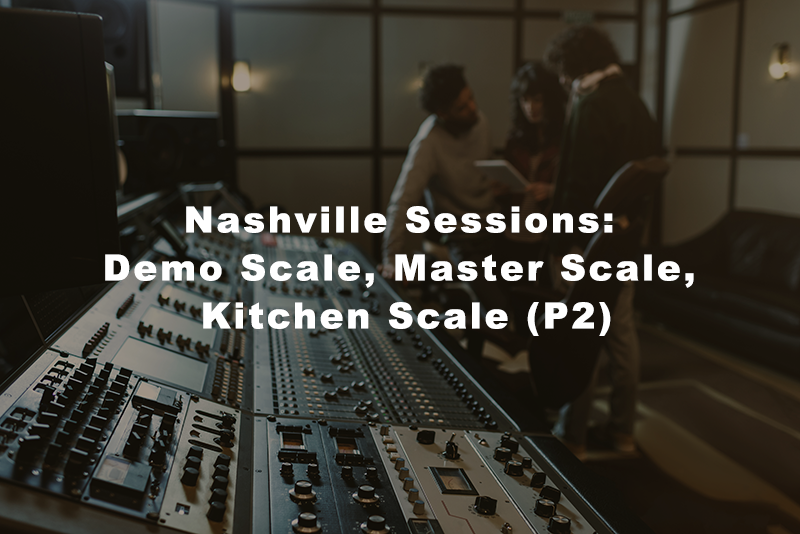Nashville Sessions: Demo Scale, Master Scale, Kitchen Scale (P2)
*** If you haven’t read part 1, you can find it here. ***
Times have sure changed in Nashville (and everywhere else) since my plane first landed there 15+ years ago. You’ve heard about it, unless you’ve been living under a rock. Big shakeup in the music industry. Digital revolution. Sales plummeting. Numbers of major record labels dwindling. The term “professional songwriter”, one who writes strictly for other artists, is becoming if not extinct, then severely endangered. Songwriters now can’t depend on “album cuts” alone. Heck, they can’t depend on “singles” either. Nobody seems to be making as much money [from music] as they used to.
With that, new opportunities are arising, all at the same time. The idea that one could make a living as a recording musician working primarily from a home studio, merely a decade ago, was inconceivable. Just acquiring the necessary equipment and software for quality studio recording was cost prohibitive back then. Not anymore.
So what do various session scales mean to me today, as I do most of my recording work in my studio, rarely meeting my clients face-to-face? Something totally different.
Over 60% of my work is recording vocals. Vocalists aren’t usually part of the gang when it comes to tracking sessions. Still, there is a distinction between “demo” and “master” (or “work-for-hire”) scales for vocalists too – one is lower but more restrictive, the other higher but more inclusive. [Once again, “demo” means demonstration use only, while “work-for-hire” includes commercial use.] And many Nashville session singers still have 2 respective rates to this day.
Until recently, so did I. Not anymore.
The way I see it, demo scale is losing its place. As mentioned before, there aren’t as many professional songwriters as there used to be. Consequently, fewer demos are being recorded strictly for pitching to artists. From a songwriter’s standpoint, it makes less and less sense to produce a killer recording which you then can’t turn around and submit to iTunes, YouTube, Spotify, etc. It’s your song after all, right?
And from a session musician’s perspective, how can one really enforce “no commercial use” restriction, unless you know the client well or have the union watching your back? It’s becoming too frustrating and time-consuming, to explain and justify the difference between pay scales, particularly when working remotely.
So I stopped doing that and simplified my rates. Now all my sessions include possible commercial use of the recording. Now all my sessions are “work-for-hire”. If you need a release document, you can have it. It may not give you the right to use my name, but you will own my tracks you paid for and can use them at your discretion, without owing me any royalties in the future. Sounds short and sweet? I think so.
There are a few more considerations to keep in mind, when setting a price for online recording services. Most of them have to do with time management.
Time in studio. Back in my in-person session days… Sure, I had to prep before the session, get dressed appropriately, get in my car and drive, arrive to studio on time, etc. But once I got there and did my part to producer’s (or client’s) satisfaction, an hour or so later I was done. Not so with online sessions. Why not? Read on!
More time in studio. At a live recording session, a sound engineer is present, so all I need to worry about is singing or playing my heart out. For online recording, time needs to be invested to acquire some engineering skills, in order to be able to competently record tracks.
Remote aspect. When you’re in the studio with a client, they can direct you right there and then – and you’re able to efficiently change approaches on the fly. With remote recording, the client isn’t there and you just have to do your best getting “inside their head” and giving them what you think they want. Some clients have no problem letting go and letting musicians “do their thing”, some are more hands-on. You have to try to please both kinds and be open to possible revisions.
Time zones. Working with clients around the globe, it’s very often that I only get feedback about my work the next day. So you better jot down all your settings and mic positions, before you jump onto your next session, ya hear?
Language barriers. Not all clients, especially from overseas, may speak English as clearly as what you’re used to. Still, it is your job to first decipher exactly what they are looking for and then endeavor to deliver it. On these sessions, you are essentially both the musician AND the producer.
Fees. Finally, when working through an online platform such as AirGigs, you have to also remember to allow room in your rate for their commission.
Once you consider all these factors and figure out what your time, skills and talents are worth, dive right in! It’s a brave new digital world out there.
Disclaimer:
Any experiences, observations and opinions expressed here are my own, so they are completely subjective and biased. I’m sure many better minds would laugh and tell me to go wash my hair instead. And I just might. I have long hair.

